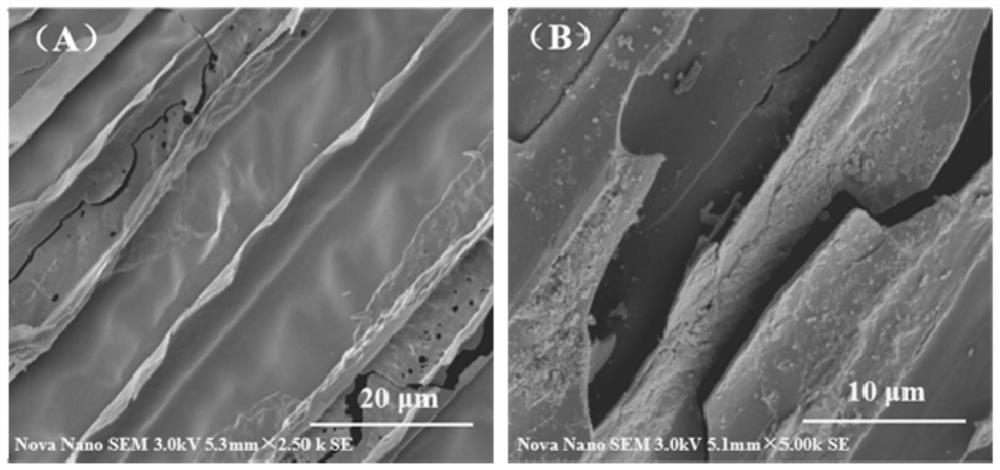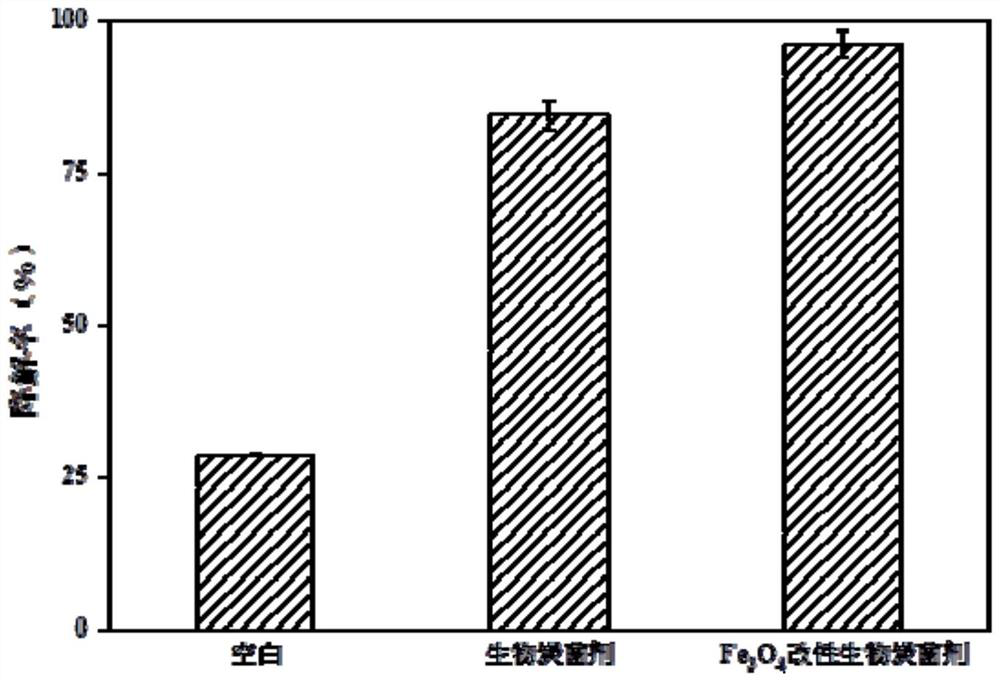Ferroferric oxide modified biochar immobilized polycyclic aromatic hydrocarbon degrading bacterial agent as well as preparation and application thereof
A technology of triiron tetroxide and polycyclic aromatic hydrocarbons, which is applied in biochemical equipment and methods, fixed on or in inorganic carriers, microorganisms, etc., can solve the problem of the need to improve the degradation rate, achieve good degradation activity, and improve preservation. Effect of time and adhesion area increase
- Summary
- Abstract
- Description
- Claims
- Application Information
AI Technical Summary
Problems solved by technology
Method used
Image
Examples
Embodiment 1
[0040] Fe 3 o 4 Preparation of modified biochar
[0041] FeCl 3 and FeSO 4 ·7H 2 O is added in the beaker that deionized water is housed, stirs until dissolving completely, makes iron salt solution (wherein, component concentration is: 0.025mol / L FeCl 3 , 0.0125mol / L FeSO 4 ·7H 2 O). Mix 20g 30-80 mesh cotton stalk biochar with 1L iron salt solution and stir at about 65°C for 20min
[0042] A 10M NaOH solution was added until the pH was 11. After mixing for 1 hour, age at room temperature for 24 hours and filter. The remaining solid particles were washed repeatedly with deionized water and ethanol. Finally, the prepared biochar was dried in an oven. Made Fe 3 o 4 Modified biochar. Cotton stalk biochar, Fe 3 o 4 Scanning electron microscope image of modified biochar figure 1 As shown, it can be observed that the cotton stalk biochar has an obvious pore structure, the arrangement is regular, and the surface is relatively smooth and flat. 3 o 4 After modificati...
Embodiment 2
[0044] Fe 3 o 4 Preparation of modified biochar-immobilized polycyclic aromatic hydrocarbon degrading bacteria agent
[0045] Use an inoculation loop to pick a strain from the LB plate of AD-3 (Martelella sp.AD-3) and inoculate it in 5 mL of LB medium. After culturing for 48 hours, take out the Erlenmeyer flask and wash the cells repeatedly.
[0046] According to the volume ratio of 5% inoculum, take the expanded cultured bacterial solution and add it to a conical flask filled with 20mL 3% LB. The culture conditions are: rotation speed 180rpm, temperature 28°C, culture for 36h, centrifuge after the end, remove the supernatant . Resuspend in 20 mL 3% LB, OD 600 Adjust to 0.6 to obtain AD-3 bacterial liquid
[0047] Take by weighing the Fe prepared by 0.5g above-mentioned embodiment 1 3 o 4 The modified biochar was sterilized under high temperature and high pressure at 121°C for 20min, cooled to room temperature, added 20mL of AD-3 bacteria solution, placed in a constant t...
Embodiment 3
[0049] Fe 3 o 4 Degradation performance of modified biochar immobilized polycyclic aromatic hydrocarbon degrading bacteria agent
[0050] Adopt the Fe prepared by embodiment 2 3 o 4 The modified biochar-immobilized polycyclic aromatic hydrocarbon degrading bacteria agent was used in the PHE degradation experiment. The content of polycyclic aromatic hydrocarbons in the system was determined by high performance liquid chromatography (HPLC). Its degradation rate is as image 3 As shown, Fe 3 o 4 The degradation rate of 200 mg / L phenanthrene by the modified biochar-immobilized bacterial agent can reach 96.33% within 24 hours, while the degradation rate of phenanthrene by the cotton stalk biochar-immobilized bacterial agent is 84.51% under the same conditions, indicating that Fe 3 o 4 The modification improved the degradation effect of the biochar agent.
PUM
 Login to View More
Login to View More Abstract
Description
Claims
Application Information
 Login to View More
Login to View More - R&D
- Intellectual Property
- Life Sciences
- Materials
- Tech Scout
- Unparalleled Data Quality
- Higher Quality Content
- 60% Fewer Hallucinations
Browse by: Latest US Patents, China's latest patents, Technical Efficacy Thesaurus, Application Domain, Technology Topic, Popular Technical Reports.
© 2025 PatSnap. All rights reserved.Legal|Privacy policy|Modern Slavery Act Transparency Statement|Sitemap|About US| Contact US: help@patsnap.com



